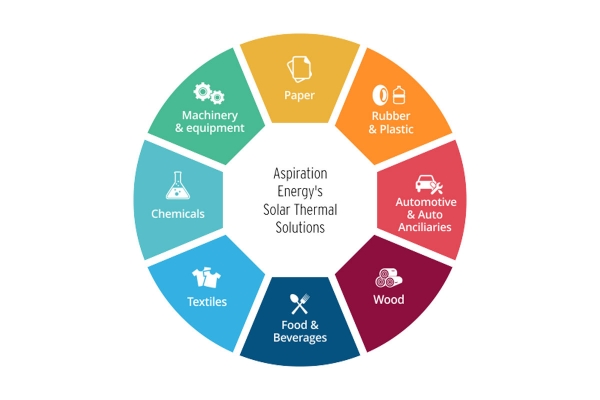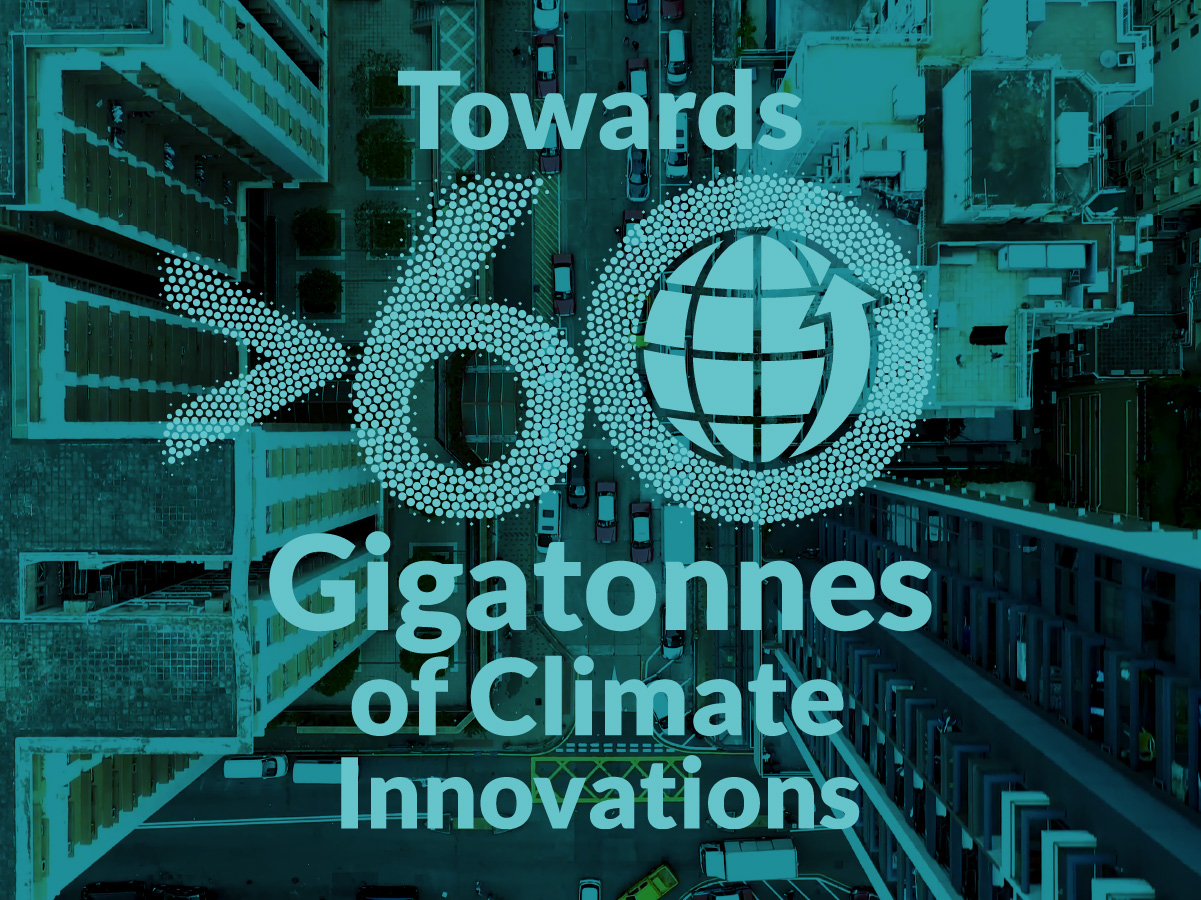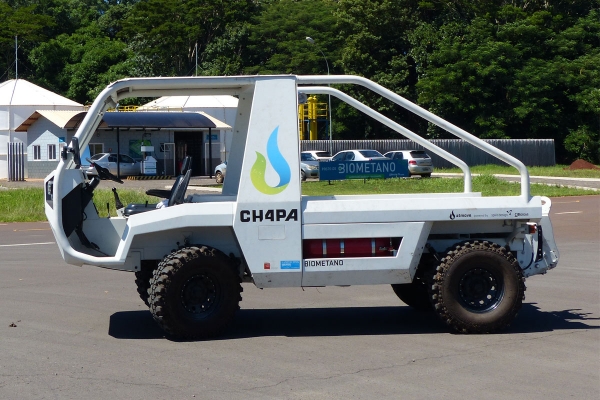Nominated innovations
1000 innovative clean energy solutions and > 150 framework enablers with the potential to deliver more than twelve gigatonnes of avoided emissions by 2030
These assessments are based on a basic avoided emission assessment. The overall concept of avoided emissions is that a solution (product or service) enables the same function to be performed with significantly less GHG emissions. The method of measuring avoided emissions, is to compare a baseline scenario without the enabling solution, with a scenario using the enabling solution; whereby the baseline represents the ‘business as usual’ (BAU) scenario.
These assessments are based on the framework document: The Avoided Emissions Framework (AEF) from September 2020

Decentralised solar thermal system for industries
Traditionally, industries use electricity, high speed diesel or furnace oil to achieve process heat temperatures ranging from 70 to 120 °C. Aspiration Energy has developed a solution to meet low and mid temperature process heat demand through decentralized energy generation based on a solar thermal system. Although solar collectors generally heat up to about 70°C, Aspiration’s innovations in fluid pressure, as well as system and module design, have been able to achieve temperatures of up to 120 °C.
India

Aspiration Energy private limited
Decentralised solar thermal system for industries
Traditionally, industries use electricity, high speed diesel or furnace oil to achieve process heat temperatures ranging from 70 to 120 °C. Aspiration Energy has developed a solution to meet low and mid temperature process heat demand through decentralized energy generation based on a solar thermal system. Although solar collectors generally heat up to about 70°C, Aspiration’s innovations in fluid pressure, as well as system and module design, have been able to achieve temperatures of up to 120 °C.
Currently unavailable

Smart rice cultivation
Farmers can use Alternate Wetting and Drying (AWD) as a more efficient method of rice cultivation. This involves allowing fields to dry down between floods on rice fields. By decreasing the amount of time fields remain flooded, AWD reduces water use, fuel and electricity use for running irrigation pumps, and the need for nitrogen fertilizers, while also slowing down the anaerobic activity that creates methane gas. However, AWD can be challenging. It requires farmers to control water levels carefully across large tracts of land. It also introduces risk to the rice crops, as it can be difficult to assess depth accurately with only a few measurements at various points in the fields. Together, these barriers have slowed adoption of AWD. AT&T connectivity enables water-level data to be remotely collected and connected to pumping systems to automatically control the water level in the rice fields. This helps both with the implementation of the AWD process and with the data collection required for verification of the carbon credits. Thus the technology helps to overcome barriers to implementation and increases the AWD adoption rate. Current avoided annual emissions calculated based on adoption of IoT-enabled AWD expanded to all rice farmers in Arkansas, Louisiana, Mississippi, Missouri and Texas. http://about.att.com/content/dam/csr/otherpdfs/10x-Precision-King-FINAL.pdf
United States

AT&T
Smart rice cultivation
Farmers can use Alternate Wetting and Drying (AWD) as a more efficient method of rice cultivation. This involves allowing fields to dry down between floods on rice fields. By decreasing the amount of time fields remain flooded, AWD reduces water use, fuel and electricity use for running irrigation pumps, and the need for nitrogen fertilizers, while also slowing down the anaerobic activity that creates methane gas. However, AWD can be challenging. It requires farmers to control water levels carefully across large tracts of land. It also introduces risk to the rice crops, as it can be difficult to assess depth accurately with only a few measurements at various points in the fields. Together, these barriers have slowed adoption of AWD. AT&T connectivity enables water-level data to be remotely collected and connected to pumping systems to automatically control the water level in the rice fields. This helps both with the implementation of the AWD process and with the data collection required for verification of the carbon credits. Thus the technology helps to overcome barriers to implementation and increases the AWD adoption rate. Current avoided annual emissions calculated based on adoption of IoT-enabled AWD expanded to all rice farmers in Arkansas, Louisiana, Mississippi, Missouri and Texas. http://about.att.com/content/dam/csr/otherpdfs/10x-Precision-King-FINAL.pdf
Currently unavailable

Solar energy harvesting in Chile's desert
The Atacama Desert, located in northern part of Chile, has special conditions that need the development of technologies to allow an efficient solar energy generation. The area presents an average direct global radiation level of 3.500 kWh/m² per annum and an horizontal global radiation level of 2.500 kWh/m² per annum, one of the highest in the world. The solution is a new optimal solar technology to be used in the Atacama Desert. The development includes new materials to resist high radiation levels, a bifacial photovoltaic panel to take advantage of the radiation and the ground and new methods for operation and maintenance considering the lack of water in the desert.
Chile

AtaMos-TeC
Solar energy harvesting in Chile's desert
The Atacama Desert, located in northern part of Chile, has special conditions that need the development of technologies to allow an efficient solar energy generation. The area presents an average direct global radiation level of 3.500 kWh/m² per annum and an horizontal global radiation level of 2.500 kWh/m² per annum, one of the highest in the world. The solution is a new optimal solar technology to be used in the Atacama Desert. The development includes new materials to resist high radiation levels, a bifacial photovoltaic panel to take advantage of the radiation and the ground and new methods for operation and maintenance considering the lack of water in the desert.
Currently unavailable

Empowering healthy decision-making
Atlas Sensing Labs wrote: In a world where air pollution causes 6. 5 million premature deaths annually, in europe 500,000, there are still hundreds of thousands of cities (population > 50,000) where no air quality network exists. Air pollution can not be controlled without data. Our solution provides any urban area with a hyper-local monitoring network combined with modeling for the high spatial-temporal data needed for effective policy decision-making at an accessible price. Lower air pollution levels mean: fewer premature deaths; major savings on health, agriculture, infrastructure, the environment; while also having significant co-benefits for climate change... Source: EIT Climate KIC's ClimateLaunchPad
Switzerland

Atlas Sensing Labs
Empowering healthy decision-making
Atlas Sensing Labs wrote: In a world where air pollution causes 6. 5 million premature deaths annually, in europe 500,000, there are still hundreds of thousands of cities (population > 50,000) where no air quality network exists. Air pollution can not be controlled without data. Our solution provides any urban area with a hyper-local monitoring network combined with modeling for the high spatial-temporal data needed for effective policy decision-making at an accessible price. Lower air pollution levels mean: fewer premature deaths; major savings on health, agriculture, infrastructure, the environment; while also having significant co-benefits for climate change... Source: EIT Climate KIC's ClimateLaunchPad
Currently unavailable

Decentralized biomethane mobility solutions
Atmove offers products and services necessary for decentralized biomethane mobility. The Atmove circular economy system offers an integration of biogas infrastructure to use organic waste from the agriculture, biomethane upgrading, BioGNG filling stations, vehicles and services within a one-stop-shop. According to Atmove, their solution compared to fossil alternatives cuts fuel costs by 50% and CO₂ emissions by 90% with a standardized product range that covers 80 % of the market needs.
Brazil
≈100

Atmove
Decentralized biomethane mobility solutions
Atmove offers products and services necessary for decentralized biomethane mobility. The Atmove circular economy system offers an integration of biogas infrastructure to use organic waste from the agriculture, biomethane upgrading, BioGNG filling stations, vehicles and services within a one-stop-shop. According to Atmove, their solution compared to fossil alternatives cuts fuel costs by 50% and CO₂ emissions by 90% with a standardized product range that covers 80 % of the market needs.
≈100Mt CO2e/year

Energy efficient ceiling fan
Atomberg Technologies aims to use their innovative Gorilla Ceiling Fan to reduce power consumption of cooling compared to conventional fans. The company claims that, whereas other fans consume around 75 Watts at full speed, Gorilla fans consume only 28 Watts; achieved using a brushless DC motor design and a driving algorithm called “atomsense”, which precisely senses various motor parameters in real time and controls the motor in a closed loop, avoiding power losses.
India
≈10

Atomberg Technologies Private Limited
Energy efficient ceiling fan
Atomberg Technologies aims to use their innovative Gorilla Ceiling Fan to reduce power consumption of cooling compared to conventional fans. The company claims that, whereas other fans consume around 75 Watts at full speed, Gorilla fans consume only 28 Watts; achieved using a brushless DC motor design and a driving algorithm called “atomsense”, which precisely senses various motor parameters in real time and controls the motor in a closed loop, avoiding power losses.
≈10Mt CO2e/year

ATS WorldWide
ATS WorldWide wrote: The idea was born during a casual conversation with a friend pilot. He said that from the moment of landing at the airport, only by the gate his plane burned more than 2 tons of aviation fuel! what a waste . We solved the problem that the entire aviation industry could not handle since the 1970s. If the ats is implemented the fuel cost savings only at three european airports: frankfurt, heathrow, parics will amount to 749. 400. 000 eur!. The following amounts of gases are released into the environment during aircraft taxiing procedures at these three european airports every year: hc - - hydrocarbons - 1. 602. 850 kg. Nox - carcinogenic nitric oxides - 4. 309. 050 kg. Co - lethal damp, carbon monoxide - 19. 315. 799 kg... Source: EIT Climate KIC's ClimateLaunchPad
Poland

ATS WorldWide
ATS WorldWide
ATS WorldWide wrote: The idea was born during a casual conversation with a friend pilot. He said that from the moment of landing at the airport, only by the gate his plane burned more than 2 tons of aviation fuel! what a waste . We solved the problem that the entire aviation industry could not handle since the 1970s. If the ats is implemented the fuel cost savings only at three european airports: frankfurt, heathrow, parics will amount to 749. 400. 000 eur!. The following amounts of gases are released into the environment during aircraft taxiing procedures at these three european airports every year: hc - - hydrocarbons - 1. 602. 850 kg. Nox - carcinogenic nitric oxides - 4. 309. 050 kg. Co - lethal damp, carbon monoxide - 19. 315. 799 kg... Source: EIT Climate KIC's ClimateLaunchPad
Currently unavailable

BikeBuddy
Attractive Cyclists wrote: We gathered extensive geographical data from the openstreetmap, including the positions of street lights and tram tracks in the city of heidelberg. Using the openrouteservice, we generated various routes within heidelberg and analysed their properties with regard to these features. As a proof of concept, we implemented an application that can generate three routes between two points: the shortest one, the one with the highest proportion of illumination, and the one with the smallest intersection with the tram tracks. As a motivational gimmick, the amount of co2 saved by not using an (average) car for this distance is displayed... Source: EIT Climate KIC's Climathon
Germany

Attractive Cyclists
BikeBuddy
Attractive Cyclists wrote: We gathered extensive geographical data from the openstreetmap, including the positions of street lights and tram tracks in the city of heidelberg. Using the openrouteservice, we generated various routes within heidelberg and analysed their properties with regard to these features. As a proof of concept, we implemented an application that can generate three routes between two points: the shortest one, the one with the highest proportion of illumination, and the one with the smallest intersection with the tram tracks. As a motivational gimmick, the amount of co2 saved by not using an (average) car for this distance is displayed... Source: EIT Climate KIC's Climathon
Currently unavailable

Hydrogen based battery
Aude Opus wrote: Aude opus provides hydrogen based batteries for long term electricity storing. To make renewable energy consistent and trustworthy we need to have an electricity storing solution, which can provide electricity for a long periods time. In order to go full on renewable energy we need to electricity storage solution. To create that, aude opus combines already existing new technologies in a single product... Source: EIT Climate KIC's ClimateLaunchPad
Estonia

Aude Opus
Hydrogen based battery
Aude Opus wrote: Aude opus provides hydrogen based batteries for long term electricity storing. To make renewable energy consistent and trustworthy we need to have an electricity storing solution, which can provide electricity for a long periods time. In order to go full on renewable energy we need to electricity storage solution. To create that, aude opus combines already existing new technologies in a single product... Source: EIT Climate KIC's ClimateLaunchPad
Currently unavailable

A textile that generates energy
AUG-TEX wrote: Like it or not we are dependant on technology and technology is dependant on batteries when battaries run out of juice the technology becomes useless. This makes us dependant on localized energy sources. Currently mankind is developing better energy capacitors and the best of them are made from lithium. We make new types of batteries that charge the batteries in our devices if we are not able to use localized energy sources. The mining of lithium has already shown its harmful effects on our enviroment and it's a growing market therefore we propose an alternative solution to decrease the demand of batteries and therefore the demand for lithium... Source: EIT Climate KIC's ClimateLaunchPad
Estonia

AUG-TEX
A textile that generates energy
AUG-TEX wrote: Like it or not we are dependant on technology and technology is dependant on batteries when battaries run out of juice the technology becomes useless. This makes us dependant on localized energy sources. Currently mankind is developing better energy capacitors and the best of them are made from lithium. We make new types of batteries that charge the batteries in our devices if we are not able to use localized energy sources. The mining of lithium has already shown its harmful effects on our enviroment and it's a growing market therefore we propose an alternative solution to decrease the demand of batteries and therefore the demand for lithium... Source: EIT Climate KIC's ClimateLaunchPad
Currently unavailable